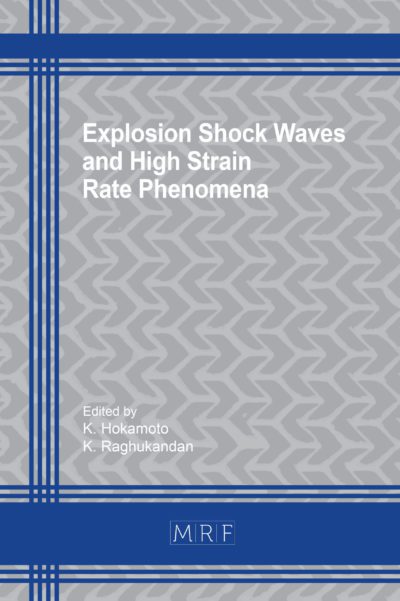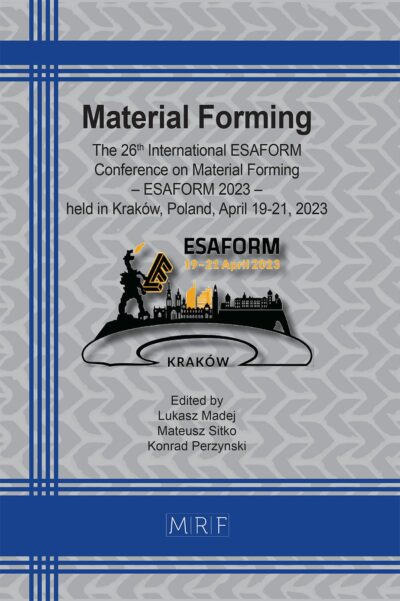–
Enhancing metal-forming predictions with VR-infused digital twin models
URIBE David, BAUDOUIN Cyrille, LOCARD Yoan, DURAND Camille, BIGOT Régis
download PDFAbstract. This article presents a two-step method to enhance metal-forming predictions by integrating Virtual Reality (VR) into Digital Twin models, focusing on single-blow cold copper upsetting operations. The process begins with developing a real-time predictive surrogate model that considers actual process parameters, acting as a crucial link between conventional numerical simulations and immediate decision-making. Subsequently, the surrogate model is integrated into a realistic VR environment, aligned with the experimental forging setup. The study underscores the need and potential advantages of real-time digital twins in the forging field, emphasizing the bridging capability between numerical simulations and instant decision-making through predictive modeling and immersive virtual environments.
Keywords
Digital Twin, Virtual Reality, Forging Process, Surrogate Model, Numerical Simulation
Published online 4/24/2024, 11 pages
Copyright © 2024 by the author(s)
Published under license by Materials Research Forum LLC., Millersville PA, USA
Citation: URIBE David, BAUDOUIN Cyrille, LOCARD Yoan, DURAND Camille, BIGOT Régis, Enhancing metal-forming predictions with VR-infused digital twin models, Materials Research Proceedings, Vol. 41, pp 2309-2319, 2024
DOI: https://doi.org/10.21741/9781644903131-254
The article was published as article 254 of the book Material Forming
![]() Content from this work may be used under the terms of the Creative Commons Attribution 3.0 license. Any further distribution of this work must maintain attribution to the author(s) and the title of the work, journal citation and DOI.
Content from this work may be used under the terms of the Creative Commons Attribution 3.0 license. Any further distribution of this work must maintain attribution to the author(s) and the title of the work, journal citation and DOI.
References
[1] J. Goulding, W. Nadim, P. Petridis, et M. Alshawi, « Construction industry offsite production: A virtual reality interactive training environment prototype », Advanced Engineering Informatics, vol. 26, no 1, p. 103 116, janv. 2012. https://doi.org/10.1016/j.aei.2011.09.004
[2] M. Grieves et J. Vickers, « Digital Twin: Mitigating Unpredictable, Undesirable Emergent Behavior in Complex Systems », in Transdisciplinary Perspectives on Complex Systems: New Findings and Approaches, F.-J. Kahlen, S. Flumerfelt, et A. Alves, Éd. Cham: Springer International Publishing, 2017, p. 85 113. doi: 10.1007/978-3-319-38756-7_4
[3] R. Stark, C. Fresemann, et K. Lindow, « Development and operation of Digital Twins for technical systems and services », CIRP Annals, vol. 68, no 1, p. 129 132, 2019. https://doi.org/10.1016/j.cirp.2019.04.024
[4] K.-J. Wang, Y.-H. Lee, et S. Angelica, « Digital twin design for real-time monitoring – a case study of die cutting machine », International Journal of Production Research, vol. 59, no 21, p. 6471 6485, nov. 2021. https://doi.org/10.1080/00207543.2020.1817999
[5] D. Uribe, C. Baudouin, C. Durand, et R. Bigot, « Predictive control for a single-blow cold upsetting using surrogate modeling for a digital twin », Int J Mater Form, vol. 17, no 1, p. 7, déc. 2023. https://doi.org/10.1007/s12289-023-01803-x
[6] D. Uribe, C. Durand, C. Baudouin, P. Krumpipe, et R. Bigot, « Towards the Real-Time Piloting of a Forging Process: Development of a Surrogate Model for a Multiple Blow Operation », in Proceedings of the 14th International Conference on the Technology of Plasticity – Current Trends in the Technology of Plasticity, Cham, 2023, p. 377 388. doi: 10.1007/978-3-031-41341-4_39
[7] K. Slimani, M. Zaaf, et T. Balan, « Accurate surrogate models for the flat rolling process », International Journal of Material Forming, vol. 16, mars 2023. https://doi.org/10.1007/s12289-023-01744-5
[8] M. Schonlau, « Computer experiments and global optimization », Doctoral Thesis, University of Waterloo, 1997. Consulté le: 15 mai 2023. [En ligne]. Disponible sur: https://uwspace.uwaterloo.ca/handle/10012/190
[9] L. Dammacco, R. Carli, V. Lazazzera, M. Fiorentino, et M. Dotoli, « Designing complex manufacturing systems by virtual reality: A novel approach and its application to the virtual commissioning of a production line », Computers in Industry, vol. 143, p. 103761, déc. 2022. https://doi.org/10.1016/j.compind.2022.103761
[10] V. Weistroffer, F. Keith, A. Bisiaux, C. Andriot, et A. Lasnier, « Using Physics-based Digital Twins and Extended Reality for the Safety and Ergonomics Evaluation of Cobotic workstations », Frontiers in Virtual Reality, vol. 3, p. https://doi.org/10.3389/frvir.2022.781830, 2022. https://doi.org/10.3389/frvir.2022.781830
[11] onnx/tensorflow-onnx. Open Neural Network Exchange, 2024. Consulté le: 5 février 2024. [online]. Available on: https://github.com/onnx/tensorflow-onnx














